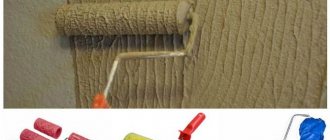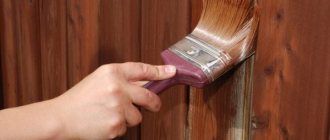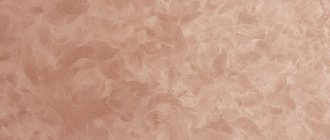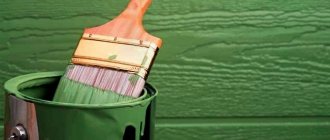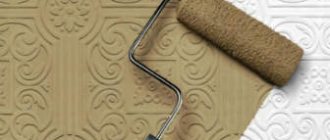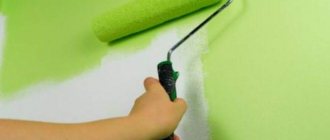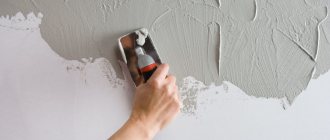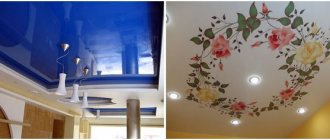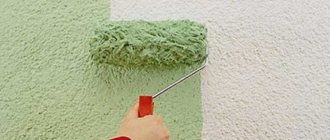Plastered walls do not always require additional finishing, but if the specified layer is rough, then cladding is necessary. Painting plaster is the most common finishing method. To apply a decorative coating, the master does not require special knowledge, so all the work can be done independently.
Features of preparing walls for painting
Before painting the plaster, the base must be prepared. For this purpose, the following actions are carried out:
- Cleaning walls from dust, grease and dirt stains, and old decorative coating.
- Elimination of all chips, cracks, potholes. A cement solution is used for the work.
- Sanding the plastered base. It must be perfectly smooth so that the paint lays down in an even layer.
- Priming the base. Applying special substances to the surface will improve its adhesive properties. Deep-acting formulations should be used. The priming process is carried out twice. In this case, each previous layer must dry completely.
After the base has been prepared, you need to select the appropriate type of paint and working tool.
We recommend that you read: How to properly putty walls before painting.
Advantages of facade paints
The durability and appearance of the building depends on the choice of coating Painting the facade has a number of advantages , among which are:
- Protection from moisture. Painted walls are less likely to get wet and crumble.
- Hygroscopicity of the material. This property allows the walls not to accumulate condensation that occurs due to the temperature difference between inside and outside the building.
- Slight exposure to weathering.
- Retains properties at high and low temperatures.
- Protection against penetration of harmful substances and microorganisms into the structure.
If you buy a quality product, you won’t have to worry about the appearance of the building for ten years. But for a long service life, it is important not only to choose high-quality material, but also to apply to the surface.
Selection of paint for plaster
There are a large number of compositions for decorating surfaces, but not all of them have the same properties. Paint is available on plaster for interior use and for exterior use.
For interior work
To paint the walls indoors, you need to choose the appropriate composition. It must ensure the vapor permeability of the layer, its resistance to moisture, as well as any mechanical damage. Depending on the room in which the substance will be used, it may have other characteristics.
It would be good if such a finish was comfortable and easy to clean. The material should also not contain toxic substances that will be released into the environment before or after applying the product to the surface. You can choose paint for plaster for interior work among the following varieties: acrylic, water-based, latex, alkyd, oil.
For exterior decoration
Many craftsmen are interested in whether it is possible to paint plaster on the outside. This is allowed, but the selection of a suitable composition for processing is required. They must have the following properties: resistance to moisture and ultraviolet radiation, durability, wear resistance, economical consumption per 1 m2. The paint color should not fade in the sun for a long time.
Tips for choosing colors
Only the correct selection of colors and shades creates the desired effect. While this is not critical for interior walls, it has a direct bearing on the façade. It is advisable to take into account a number of criteria:
- The shade of the roof should match the color of the external walls. When the color scheme for the top of the house has not yet been chosen, it is better to paint the walls in pastel colors.
- With a dark roof, light shades are suitable for external surfaces.
- The double color scheme will add dynamism to the appearance of the house. The walls are painted in the main color, and light colors are selected for the openings.
- Individual facade parts should be distinguished by the structure of the coating or color - the use of both options is highly undesirable.
It is necessary to take into account the style, as well as the design of the local area, including lighting.
Varieties
Correctly chosen paint for plaster will provide the desired effect for a long time. There are several types of compositions that can be used for both interior walls and facades.
Water based emulsion paint
Indoor walls are often painted using a water-based PVA-based paint. This emulsion cannot boast of a richness of shades, but the situation can be corrected with the help of coloring colors. The composition is very easy to apply, it does not contain toxic components that can be released into the environment, and it is economical. It can be used on any surface. It dries quickly.
You should not use water-based emulsion to paint surfaces in rooms with high humidity. It quickly absorbs moisture. In order for the base to be rich in color, the composition is applied in several layers. To improve the adhesion of paint to the surface, the wall is pre-primed.
Acrylic washable paint
Painting plastered walls is done with an acrylic compound if there is a high level of humidity in the room. The characteristics of the material are as follows:
- Good reaction to evaporation, so the surface can be wiped with a damp cloth, while the decorative layer does not change its attractiveness;
- It is possible to change the color using a tint, so you can use acrylic paint when decorating any interior;
- The surface after applying the composition remains matte;
- The material is affordable;
- strength;
- ease of application;
- durability.
If water gets on the treated walls, then this type of paint should not be used.
Silicate paint
This paint for walls on plaster contains liquid glass, fillers and natural coloring pigments. If the technology was followed when applying the substance to the surface, the layer will last at least 10-15 years. It is vapor permeable and resistant to sunlight. Fungus or mold does not form on a wall with such a coating.
The disadvantage of this material is poor adhesion to organic-based surfaces. Its elasticity is not very good, so cracks often appear on the finish. When exposed to heat, the coating may become deformed.
Silicone paint
Silicone paint is suitable for plastered walls. It is intended for facade work. The surface acquires hydrophobic properties and retains vapor permeability. A favorable indoor climate is maintained.
In addition to facade paints, there are silicone paints for interior work.
Alkyd and oil paint
Oil and alkyd compositions have a rich color. Once applied, they create a durable layer. But when working with them you need to use protection. The substances have a strong unpleasant odor that remains until the layer dries. The disadvantage is their high consumption and low speed of work. However, such a coating can last for a long time without requiring special care.
Choosing paint for plastered walls
If we compare the use of wallpaper and paint, the first option will be the most suitable if you plan to create a luxurious interior, focusing on details. If renovations are being carried out in an office, or an industrial premises is being improved, it would be more advisable to choose wall plaster and painting. The same applies to cases when apartment owners have limited funds, and this type of finishing will not only save time, but also finances.
To carry out painting, you need to competently choose the composition for treating the walls. Today the following paints are used for this:
- Acrylic. These compositions are popular among consumers because they have a number of properties. Walls painted with acrylic paint tolerate moisture well, so craftsmen recommend using them in bathrooms and corridors. A rich color palette, as well as an attractive price-quality ratio, makes acrylic compositions a leader in the finishing market.
- Latex. It is advisable to use these paints on plastered walls on which decorative plaster was used. Once applied to the surface, the paint forms a thin protective layer that is resistant to drops of water. Latex compositions are presented in two types of structures: glossy and matte.
- Water-based. In addition to color filler, these products are based on water and PVA glue. This material is unlikely to be suitable for painting damp rooms, but it will be appropriate if you want to create a simple environment that does not require elaborate colors. Water-based paint is rightfully considered the most affordable.
- Oily. They have a rich color range, but have a pungent odor. In addition, if you apply the material using brushes and rollers, the speed of work slows down significantly.
When choosing a composition, pay attention to the label - it should indicate the optimal temperature at which it is desirable to apply the finish, as well as the properties of the paint during operation.
Tools for work
The following tools are used for painting plaster surfaces:
- wide and narrow brushes for applying the substance;
- if the area is too large, then the use of rollers based on foam rubber or material with pile is recommended;
- grater;
- fine-grain sandpaper, with which the surface of the base is leveled and sanded;
- paint tray;
- ladder.
For work you will need protective clothing, as well as goggles and a respirator. If you have to work a lot, and the work area is large, then you can paint the plaster using a spray gun. To create a textured layer, use a roller with special attachments.
Dyeing process
How to paint cement plaster? In this case, it is best to use a water-based product. The paint will be applied easily and evenly using an electric sprayer. If such a device is not available, then you can use rollers or brushes.
The color saturation of the water-based coating will depend on the organic additives and pigment included in the composition. During the painting process, the mixture is evenly applied to the surface. Over time, the product is absorbed into the wall thanks to its liquid base and creates a breathable effect.
There is also gypsum plaster. Is it possible to start painting such a wall without putty? Definitely not. This is a mandatory stage, after which the dyeing process itself begins.
Acrylic coatings and water-dispersed compositions are suitable for the operation.
The work process looks like this:
- First, the plaster is cleaned and the edge seams are trimmed.
- This is followed by treatment with starting putty.
- After the rough draft, you need to treat the entire surface area with putty.
- Putty walls are rubbed down with sandpaper and cleaned of dirt.
- Coloring stage.
Mandatory work rules
In order for the painted wall to have a rich and rich color, the composition is applied in 2-3 layers. Each subsequent one is applied after the previous one has completely dried. In addition, it is worth considering the following rules:
- Before deciding what to paint with, you need to know the paint consumption per 1 sq.m. area (usually this parameter is indicated on the packaging with finishing);
- during work, the base should not be exposed to moisture or direct sunlight (in this case, the material will lie unevenly and spots will appear on the wall);
- if white paint was originally purchased, then it is recommended to change it using the appropriate color;
- the optimal air temperature in the room for painting work is +5 degrees and above;
- to make the composition more liquid, it is recommended to add drying oil, water or solvent to it, but this should be done gradually and in small quantities, constantly stirring;
- to protect unpainted walls from paint, masking tape is used;
- To eliminate joints when applying the decorative composition in stripes, they need to be well shaded until the layer has completely hardened.
If the furniture cannot be taken out of the room, then it must be protected with plastic wrap. Some types of paint are best applied when there are no drafts in the room. If the base coating technology is fully followed, the coating layer will adhere firmly and provide a good decorative function.
Painting instructions
To begin, the master puts on work clothes. If the paint has a pungent odor, then the room must be ventilated, but there should be no draft. The technology for doing the work is as follows:
- First, you need to cover the windows and doorways with film. If the flooring is new, you need to protect it too. You can also protect your plumbing in the same way.
- Now the working composition should be poured into the tray. It must be mixed first. At the same stage, the paint is diluted if necessary. Consumption depends on how many layers will be applied, the area of the wall, and how well the base is prepared.
- Paint should be applied from places that are difficult to reach: corner joints of walls, areas behind radiators. Sometimes painting tools with long handles are required.
- First, the composition is applied in the direction from left to right and from top to bottom. If a roller is used for work, then the first layer can be applied with a product with a long pile, then with a medium one.
After painting, you need to let the coating dry. This should happen naturally. There is no need to dry the base artificially, as streaks may appear and the paint will peel off over time. Since painting a plaster wall is not difficult, you can do it yourself.
Painting the plastered facade
Painting your house will not be difficult if you follow the recommendations of the paint manufacturers. Plaster on external walls must be completely dry. Air temperature - not lower than 5°C. External work should not be carried out in strong winds, rain or fog. Direct sunlight should not fall on the walls to be painted, otherwise their drying will be uneven and this will affect the quality of the coating.
Now look at the order in which they work.
- Before application, the façade paint is mixed with a mixer. If it needs to be diluted, then half the volume from the bucket is poured into another container and diluted to the desired consistency. Usually no more than 5-10% water is added.
- Textured plaster is easier to paint using a paint roller with long or medium pile. To do this, the material from the bucket is poured into a tray and rolled over it with a roller.
- Then paint the wall, starting from the top corner. Roll up and down one surface several times to ensure that there are no unpainted areas of the plaster. I also make sure that there are no smudges; I roll them out with a roller.
- Painting consists of two or more layers. Each one must dry before applying the next one. On average it is 4 - 6 hours.
- The consumption of façade paint on mineral plaster will be 6-8 m2/l when coated in one layer. That is, a standard nine-liter bucket is enough for about 65 m2. This primarily depends on the type of surface, its unevenness, as well as the consistency of the paint and varnish material. The least amount of paint will be used on smooth cement plaster. The maximum consumption will be for embossed decorative finishing such as “fur coat”.
- After the paint has dried, the finishing of the external walls can be considered complete.
We also recommend that you read the article on painting decorative plaster.
Caring for Painted Walls
After applying the paint, the surface must be properly cared for, which allows you to preserve the decorative properties of the material and ensure the manifestation of its technical characteristics. The coating dries completely in a few hours, but it takes up to 2 weeks to gain strength and wear resistance.
If water-based paint was used for the job, then wet cleaning of the surface is not recommended. It is better to remove dust using a dry method. Painting plaster is not a difficult task, but it is responsible. If you follow the technology, you can do all the work yourself.
